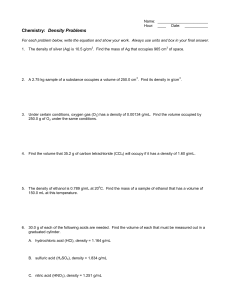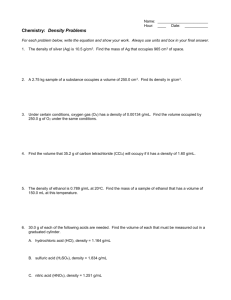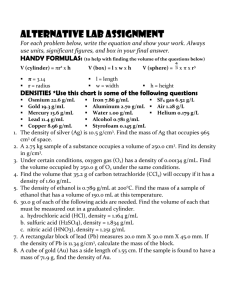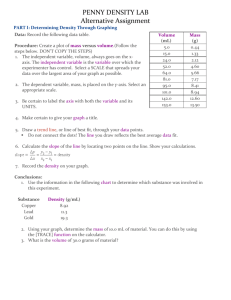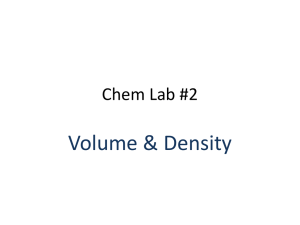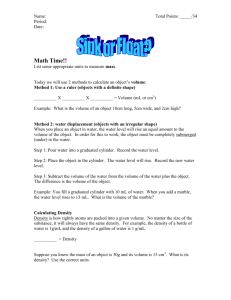Practice Density Problems
advertisement
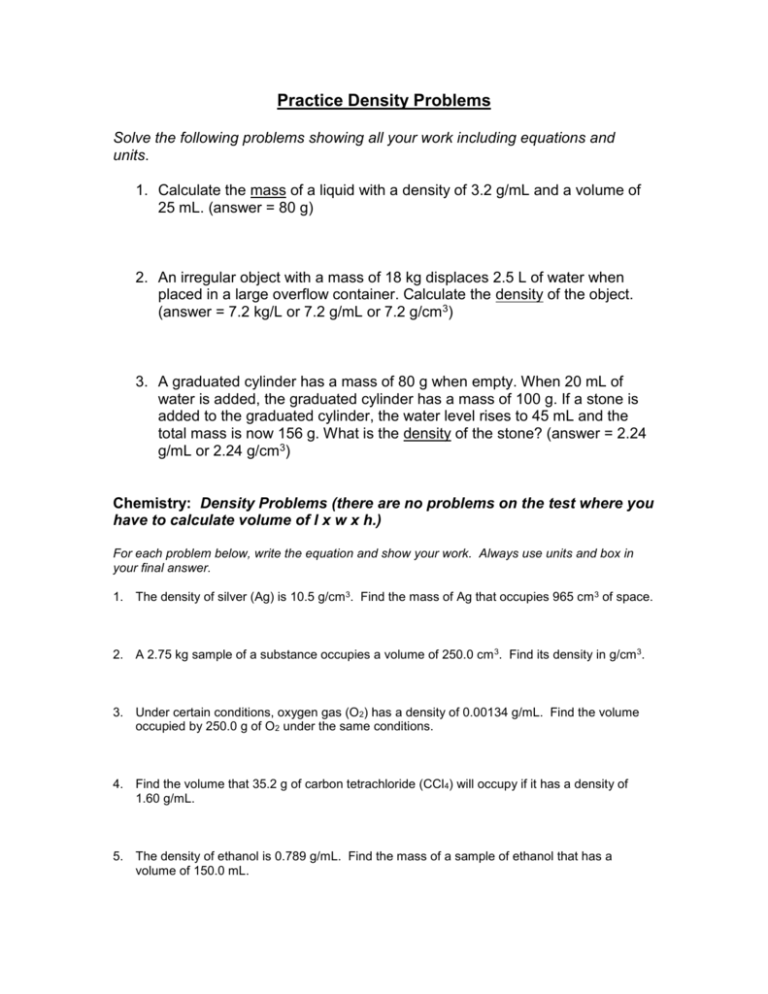
Practice Density Problems Solve the following problems showing all your work including equations and units. 1. Calculate the mass of a liquid with a density of 3.2 g/mL and a volume of 25 mL. (answer = 80 g) 2. An irregular object with a mass of 18 kg displaces 2.5 L of water when placed in a large overflow container. Calculate the density of the object. (answer = 7.2 kg/L or 7.2 g/mL or 7.2 g/cm3) 3. A graduated cylinder has a mass of 80 g when empty. When 20 mL of water is added, the graduated cylinder has a mass of 100 g. If a stone is added to the graduated cylinder, the water level rises to 45 mL and the total mass is now 156 g. What is the density of the stone? (answer = 2.24 g/mL or 2.24 g/cm3) Chemistry: Density Problems (there are no problems on the test where you have to calculate volume of l x w x h.) For each problem below, write the equation and show your work. Always use units and box in your final answer. 1. The density of silver (Ag) is 10.5 g/cm 3. Find the mass of Ag that occupies 965 cm 3 of space. 2. A 2.75 kg sample of a substance occupies a volume of 250.0 cm 3. Find its density in g/cm 3. 3. Under certain conditions, oxygen gas (O2) has a density of 0.00134 g/mL. Find the volume occupied by 250.0 g of O2 under the same conditions. 4. Find the volume that 35.2 g of carbon tetrachloride (CCl4) will occupy if it has a density of 1.60 g/mL. 5. The density of ethanol is 0.789 g/mL. Find the mass of a sample of ethanol that has a volume of 150.0 mL. 6. 30.0 g of each of the following acids are needed. Find the volume of each that must be measured out in a graduated cylinder. A. hydrochloric acid (HCl), density = 1.164 g/mL B. sulfuric acid (H2SO4), density = 1.834 g/mL C. nitric acid (HNO3), density = 1.251 g/mL 7. A rectangular block of lead (Pb) measures 20.0 mm X 30.0 mm X 45.0 mm. If the density of Pb is 11.34 g/cm3, calculate the mass of the block. 8. A cube of gold (Au) has a side length of 1.55 cm. If the sample is found to have a mass of 71.9 g, find the density of Au. 9. An irregularly-shaped sample of aluminum (Al) is put on a balance and found to have a mass of 43.6 g. The student decides to use the water-displacement method to find the volume. The initial volume reading is 25.5 mL and, after the Al sample is added, the water level has risen to 41.7 mL. Find the density of the Al sample in g/cm 3. (Remember: 1 mL = 1 cm 3.) 10. If you are sure that a sample of material is aluminum but have no measuring instruments AND are not allowed to handle the sample, how would you determine the sample’s density? 11. A gas has a mass of 3175 g and takes up enough space to fill a room that is 2.00 m X 2.00 m X 5.00 m. Use the table below, which lists densities in units of g/mL to help you determine what the gas is. (Hint: Change the units on the size of the room.) Answers: 1. 1.01 x 104 g Ag 2. 11 g/cm3 helium 3. 1.87 x 105 mL 4. 22.0 mL 5. 118.35 g ethanol 6A. 25.8 mL HCl 6B. 16.4 mL H2SO4 6C. 24.0 mL HNO3 7. 306 g Pb 8. 19.3 g/cm3 9. 2.69 g/cm3 11.
